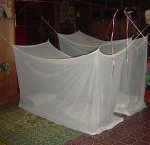Laos Wedding
Today, most people split their wedding into two parts, one is a traditional Laos wedding ceremony and the other is a modern wedding reception. Some have the traditional Laos wedding ceremony at home in the morning, when Baci ceremony takes place, and some do it in the afternoon. Only close friends and relatives are invited to join the Baci part. Whether the Baci takes place in the morning or afternoon, food and drinks are served to the guests at the end of the ceremony. The reception is then held in the evening, when more guests are invited, at a hotel, a restaurant, a hall specially caters for weddings or somewhere that could hold more people. This practice is more common among city people.
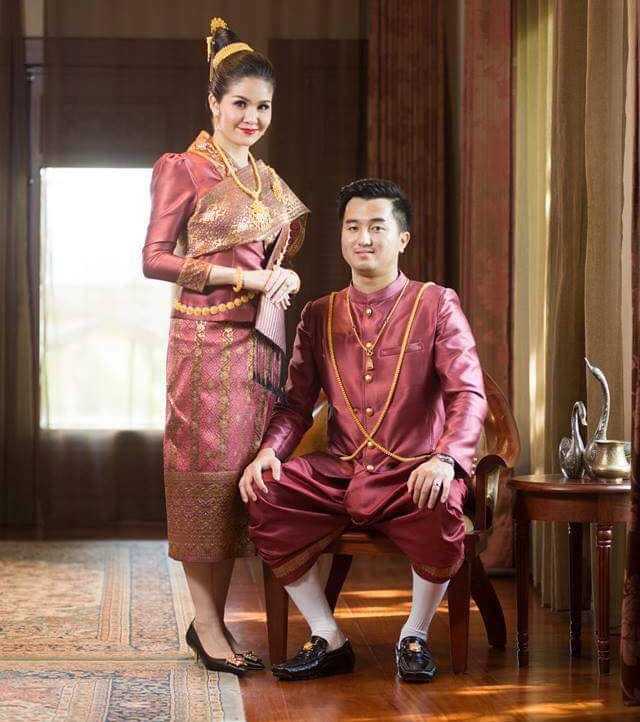 Lao Bride and Groom in traditional costume
Lao Bride and Groom in traditional costume
Photo Credit: www.facebook.com/laowedding
The traditional Laos wedding is usually held at the bride’s family home. In the past the Laos wedding was always in the morning which was believed to be convenient and best time for a joyful celebration such as wedding ceremony to take place, whereas the afternoon is considered the time for sad ceremonies like cremations. However, with modern lifestyles convenience has become more important so the time doesn’t really matter any more.
Generally, 10:00am and 4:00pm are usually considered the best times because guests are invited to have lunch or dinner after the official ceremony is finished.
Bride Price
The wedding preparations start with the Sou Khor (bride-price negotiation) procession.
The bride-price is usually money and gold, but it can be anything valuable. Traditionally this is asked by the bride's parents as a refund for the breast milk that has been fed to the bride since she was born (literally translated from Lao). How much? depends on the family social status of both sides. Nowadays many parents don't ask for anything so long that their daughter is happy.
When both sides negotiate and agree on the bride-price and all other details then they set the wedding date.
Engagement
Engagement is not that common in Laos. Some couples get engaged before their wedding while many others don't bother with the engagement at all. There are no set rules really, especially nowadays when life style of many Lao has changed.
The Best Day for Laos Wedding Procession
Traditionally, the wedding date has to be on a good day in lunar calendar, so parents of either or both sides usually consult elders or senior ex-monks, who have good knowledge of Lao custom and tradition, before the wedding date is set. One thing most Lao knows is that the wedding is not supposed to take place during the three months Khao Phansa (Buddhist Lent, late July - late October).
Today this procession has been slightly changed to suit modern lifestyles and sometimes the couple agrees on most of the details (including the bride-price) and they set the date to suit their busy lives. When it comes close to the wedding day, this Sou Khor procession is organised just for the sake of Lao custom or tradition.
Laos Wedding Preparation
The night before the Laos wedding takes place, an informal ceremony is held at the bride-to-be’s home, and sometimes the groom holds the same ceremony at his place as well. This is called Oun Dong (literally translated: wedding or marriage warming) and it only involves close friends and relatives who come to help with wedding preparations as well as to eat and drink. The things to prepare include Pha Khuan (handmade marigold pyramid made of banana leaves and flowers), food for the big day and the new couple’s bedroom. In this room tradition demands the bed must be made by the mother of the bride or an older female who has a good family (with a good husband and good children and who is not divorced, or a widow).
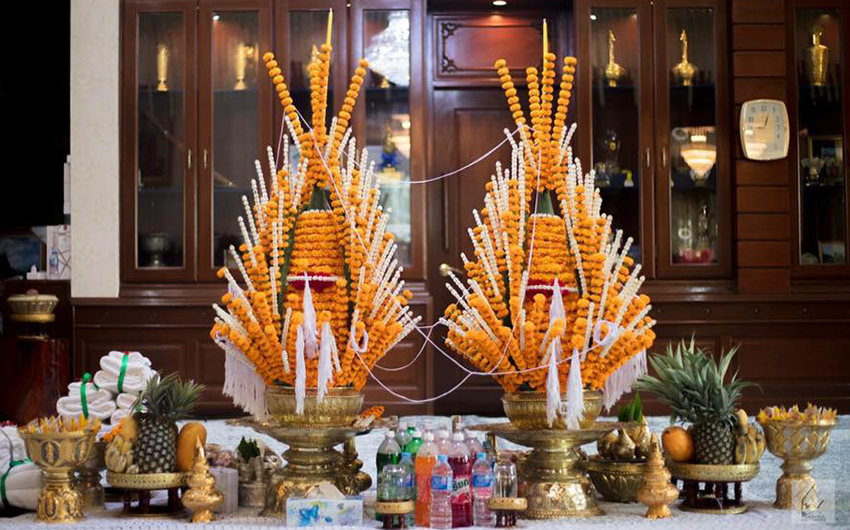 Pha Khuan: handmade marigold pyramid made of banana leaves & flowers, surrounded by fruits, drink, cooked sticky rice in baskets, boiled eggs and chicken. All make a set of Pha Khuan
Pha Khuan: handmade marigold pyramid made of banana leaves & flowers, surrounded by fruits, drink, cooked sticky rice in baskets, boiled eggs and chicken. All make a set of Pha KhuanThe Big Day
On the big day, the bride is dressed with a traditional Lao silk Sinh (Lao skirt), and silk blouse, and has her hair tied up in a special way with gold decoration. This ensemble is finished off with a gold necklace, bracelets, earrings and a bell.
The groom also gets dressed up usually with white or cream colored silk shirt and a traditional silk Salong (a pair of baggy pants). Sometimes grooms wear normal pants and suits as some find Salongs uncomfortable.
Traditionally, on the wedding day a small Baci (also spelt Basi or Sou Khuan), a spirit enhancing, ceremony is held concurrently in both the bride’s house and the groom’s prior to the formal wedding. Now many omit this custom, especially in urban areas where Lao customs and traditions are fading.
Bride Price Giving Procession
Once the small Baci is finished, a convoy of the groom is sent ahead to give the bride-price to the bride’s parents. The bride-price could be gold or money. The convoy usually consists of few older men and women, who could be the groom’s parents and relatives who are good and know a lot about Lao customs and traditions. The leader of the convoy would politely say something like “we come with horses, buffaloes, cows, a pile of silver and gold to give to you in exchange for our son to come and live your daughter” or something similar. While this exchange is taking place the groom’s group is formed and waits somewhere nearby.
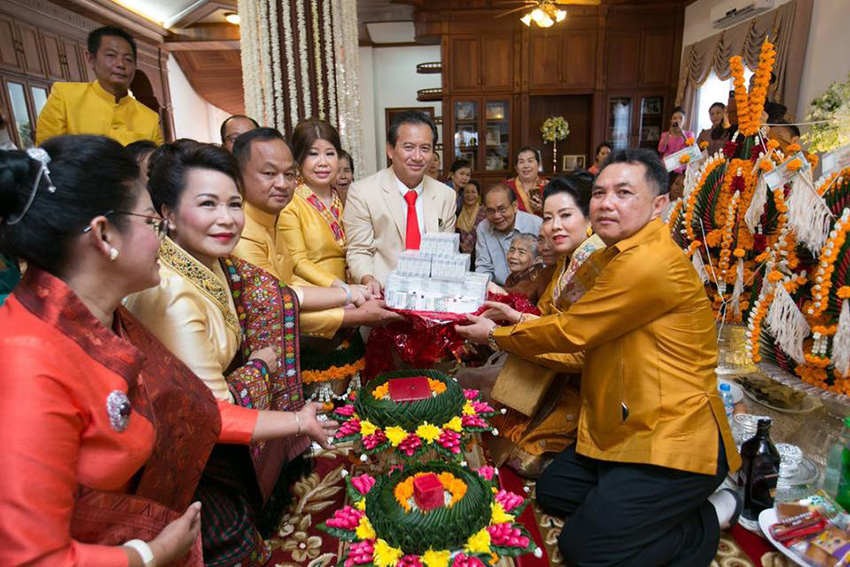 Bride Price giving procession.
Photo Credit: www.facebook.com/laowedding
Bride Price giving procession.
Photo Credit: www.facebook.com/laoweddingHae Keuy (Groom Parade)
When the bride price giving procession is finished, the groom’s group is informed and they begin to walk to the bride’s home, playing musical instruments, singing and dancing along the way (there is a song, specially composed for this procession, that sang in every groom parade) . Everybody is laughing, cheering and smiling in the most joyful way. The groom walks under an umbrella carried by his friend. This part of the Laos wedding is supposed to be really fun to join. This procession is called hae keuy (meaning groom parade).
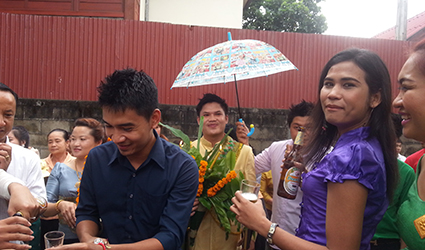 Bride's friends receive groom & his group
Bride's friends receive groom & his group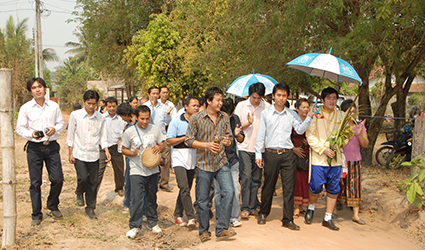 Groom Parade procession (Hae Kuey in Lao language)
Groom Parade procession (Hae Kuey in Lao language)When they arrive at the bride’s house, the groom and his party are met by the bride's relatives where a silver door and a gold door are set up and closed. These doors are just lines of silver and gold bells stretched across the door way (known as Golden and Silver Gates) to prevent the groom entering before he is granted permission. To be granted a permission the groom has to pay his way through.
The groom will be allowed to go inside only after he drinks with the bride’s party and pays them to open the doors and after their customary questions such as: “Where did you come from? What did you come here for? What did you bring with you?” etc. are answered. So… extensive bargaining, questioning and drinking takes place here which is another fun part of the Laos wedding.
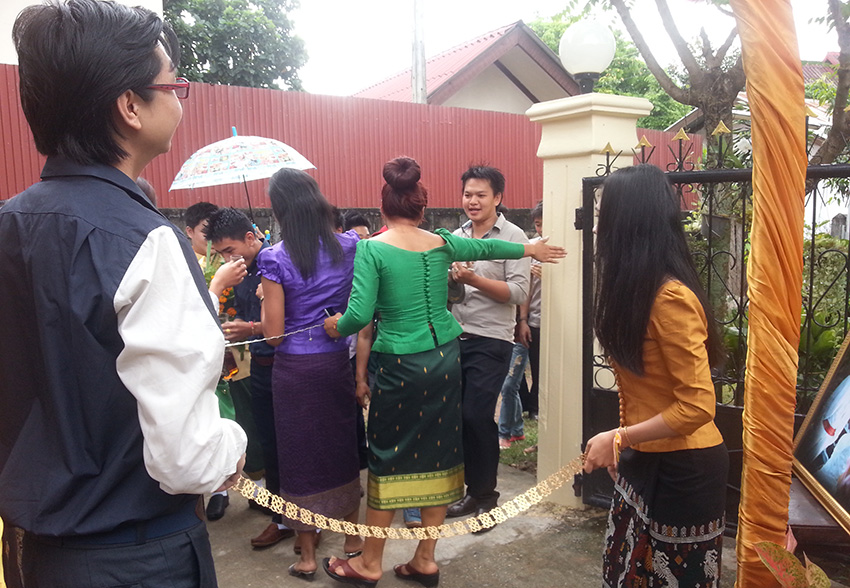 Golden and Silver Gates
Golden and Silver GatesThe groom doesn’t have to answer the questions because the elder relatives will do all the talking and answering for him. The elders from both sides talk in a customary, polite and friendly way which doesn’t have to be real. All the groom has to do is to drink his way through and give some money to the door attendants. This is like an entry fee but it doesn’t have to be much and the money would already have been prepared in advance by himself or his party. When he has paid and they are satisfied with the small money gift they will allow him to step through.
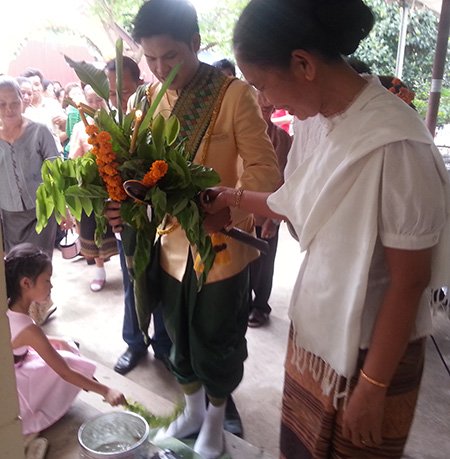 Lao wedding - Feet Washing procession
Lao wedding - Feet Washing processionHowever, it’s not finished yet. Before he can enter the house he has to have his feet washed by the bride’s younger sister, relative, or anyone chosen by the bride, but this person has to be female and had to be younger than the bride. The groom has to give a money gift to the person and then he can enter the house.
Baci or Sou Khuan Ceremony
The groom is met at the door and led by a female relative of the bride to the Pha Khoun, where the Baci ceremony will be taking place. Once he is settled in, the bride is led to the Pha Khoun from her room by another elder female relative. She is seated on the left side of the groom with the parents and relatives of both sides sitting nearby. During the seating process the bride’s relatives and friends will give her a slight push to make her to lean on the groom unintentionally, and the other party will try to push the groom the same way. It is believed that the first to touch the other one in this ceremony will have more power over the other party in their married lives.
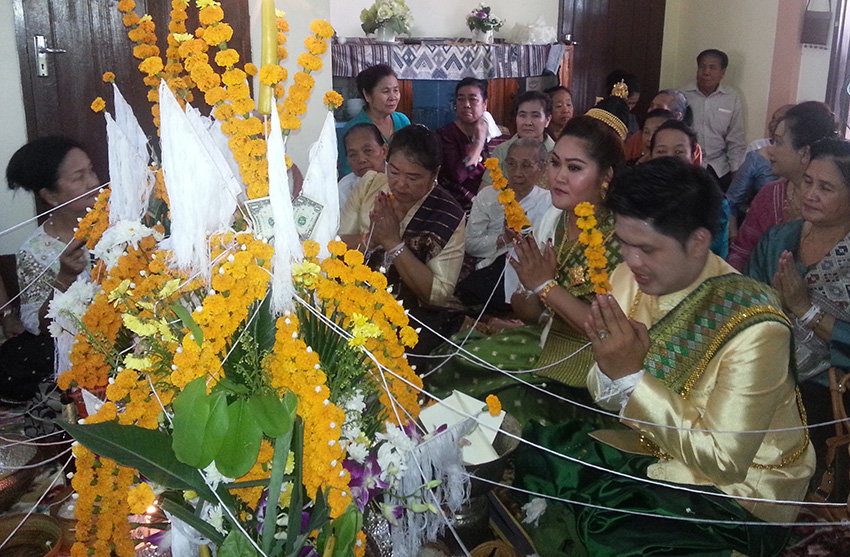 Baci Ceremony - Lao Wedding
Baci Ceremony - Lao WeddingAfter everyone is settled in, the Baci or Sou Khuan ceremony begins. This involves the chanting by the master of ceremony (Mor Phon), the egg feeding (the bride and the groom feed each other an egg) and the tying of white strings on wrists of the couple.
The Mor Phon is the first to tie white thread around the wrists of the bride and the groom. Next are the parents, and relatives of both sides. After that other guests take turns to tie the white thread on the wrists of the bride and the groom. While tying the thread everyone chants their well wishes. Some also roll a bank not or two and tied by the thread before tying on the wrists of the couple.
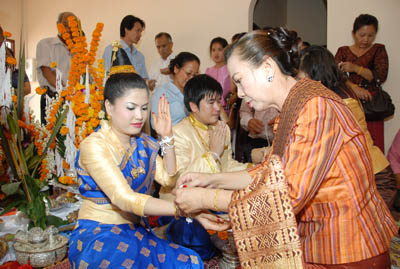 String tying on wrists
String tying on wrists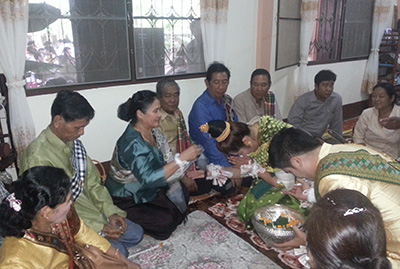 Bride & groom pay respect to parents & relatives
Bride & groom pay respect to parents & relativesSomma Procession (a customary asking for forgiveness and thanking and elder relatives of both parties)
At the end of the Baci ceremony, the elder relatives lead the couple to Somma (a customary asking for forgiveness and thanking the parents and elder relatives of both parties). This process involves the giving of small money gifts (wrapped inside banana leaves, together with flowers and a pair of candles). During this ceremony, the elders, including the parents and relatives of both parties, give the couple good wishes.
Procession of Sending the Newly Wed to Room
The Laos wedding ceremony (the Baci or Sou Khuan ceremony part) ends with the sending of the couple to their room. An elder female relative will lead the groom to the room and the bride follows behind. In the bedroom, the elderly person lead the couple to customary pay their respects to the bed and the pillows. After the procession is finished close friends and families of both sides take turns to have photo sessions with the newlywed couple in their bedroom.
Traditionally, after the procession of sending of the couple to their room, they are supposed to stay in the room until the next morning. However, this is no longer practical as the order of this ceremony has changed over time. Most have Baci or Sou Khuan ceremony in the morning and a reception in the evening. This procession (sending of the couple to their room) takes place in the morning right after the Baci ceremony, so....
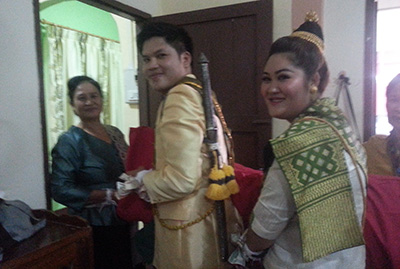 Groom's mother leads the couple to the bedroom
Groom's mother leads the couple to the bedroom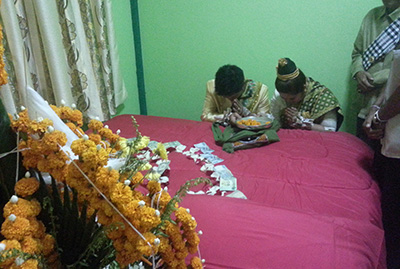 Bride & groom pay respect to the bed
Bride & groom pay respect to the bedLao Wedding Reception
After the baci is over, it is time for the party to begin when the guests are invited to eat, drink and dance.
The groom and bride will open the dance floor in Lao style dancing (called Lum Vong in Lao language) and then others will join in. Lao style dancing is a much different style, with pairs and line dancing going in circle. The party could go until late with foods and drinks (usually serve with whiskey and/or Lao Beer).
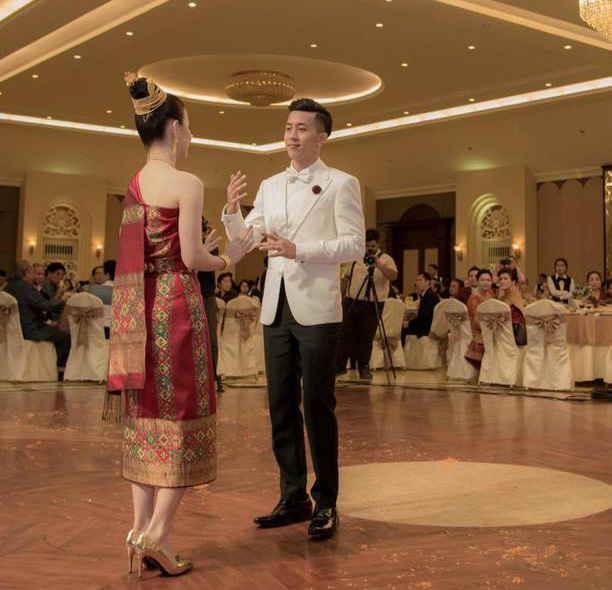 Bride and groom open the dance floor.
Photo Credit: www.facebook.com/laowedding
Bride and groom open the dance floor.
Photo Credit: www.facebook.com/laoweddingNote: The Laos wedding ceremony described here is practised by ethnic Lao and based on the author's observations and experience. It can vary from place to place or even from family to family. Other ethnic groups have their own customs and traditions which are often very different.
Tips for joining a Laos wedding ceremony or reception
If you are invited to a Laos wedding for the first time, it is helpful to know the tradition, what other people do or don't, then follow suit with confidence.
In Laos it is common to receive an invitation card about one week or just a few days before the wedding date, almost no one gives out invitation cards long in advance.
One invitation is usually intended for two people. You can take your friend, your partner, spouse or anyone really . For weddings of close friends or relatives, it is normal for parents to take young kids to the wedding reception.
It is a tradition to put some cash inside the invitation envelop and return it to the bride and groom. How much to put depends on who invites you, their family or social status, and where the reception is held. If you have no idea on the amount you should put, think if you ate in a place like that how much it would cost, that's the minimum amount you should put.
Don't worry about giving wedding gift if you don't know what the couple really need, most don't expect it. Besides it is not practical, you might spend your hard earn dollars on the best gift you can think off, but it might never get used. Instead put the amount you intend to pay for the gift in the envelop and give it to them, it will be more appreciated, because that will help cover the cost of the wedding.
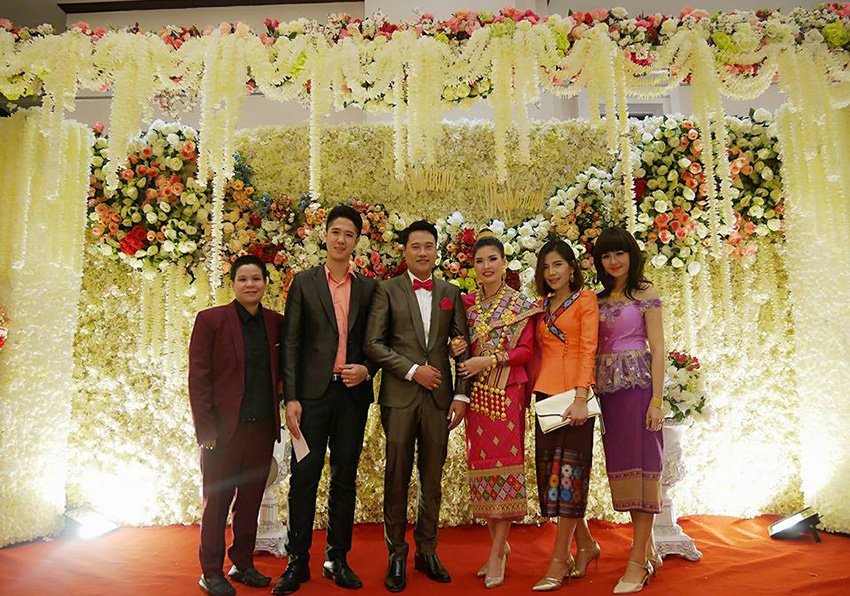 Guest Dresses & Outfits for Lao Weddings.
Photo Credit: Nini Manovan
Guest Dresses & Outfits for Lao Weddings.
Photo Credit: Nini ManovanWhat to wear to a Lao wedding
Lao ladies usually wear traditional Lao silk Sinh (Lao skirt), and silk blouse and have their hair done.
For foreigners, if you don't have a Lao skirt and Lao silk blouse, a long dress or a normal skirt and a blouse is OK, but don't go casual. It's better to overdressed than underdressed. It might not be a bad idea to cover bare shoulders with a scarf.
Men can wear normal trousers and Lao silk shirt, or a plain simple shirt with or without a tie. If you want to be a bit more formal, top that up with a suit and you will be fine.
Related: Lao Festival | Lao New Year | Lao Culture | Baci Ceremony

